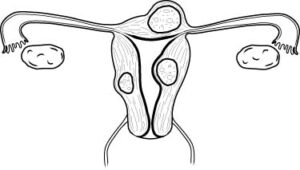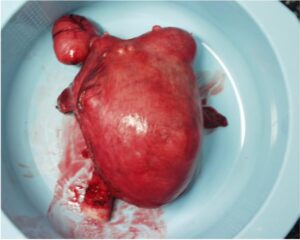Uterine leiomyomas are common, benign, smooth muscle tumors of the uterus. They are found in nearly half of women over age 40 and infrequently cause problems. Synonyms include Fibroids, Myomas, and Leiomyomata.

Fibroids tend to grow under the influence of estrogen, and regress when the estrogen levels are reduced. Thus, growth frequently occurs during pregnancy, followed by regression following delivery. After the onset of menopause, fibroids generally regress.
High-dose birth control pills, by virtue of their high estrogen content, can cause fibroids to grow larger. Low-dose birth control pills, in contrast, leave circulating estrogen levels the same (or reduced) and do not stimulate fibroid growth.
Symptoms

Most women with uterine fibroids have no symptoms, but some do. Symptoms that might be experienced include:
- Heavy menstrual flows: This happens more often with submucous fibroids (just below the surface of the endometrium) that expand the cavity size leaving a much larger surface area for bleeding. Pedunculated fibroids that protrude into the uterine cavity and also cause menorrhagia by interfering with the normal contractile mechanisms of the uterus.
- Bleeding between periods: Pedunculated fibroids and submucosal fibroids can mechanically traumatize the uterine lining, leading to dysfunctional bleeding.
- Pain: This may take the form of menstrual cramps, painful intercourse on deep penetration, pain of acute fibroid degeneration, and chronically inflamed fibroids with a dull, aching or heaviness that is mostly constant.
- Infertility: Fibroids, depending on their location, can interfere with fertility.
- Pelvic Pressure: This heaviness in the pelvis is distracting and annoying.
- Stress Urinary Incontinence: The bulk and irregular proportions of fibroids can distort the pelvic anatomy sufficiently to interfere with normal urinary retention and release.
- Ureteral Obstruction: If large enough and filling the pelvis, fibroids can put pressure on and partially obstruct the ureters, increasing the risk of infection, stones and renal disease.
Clinical Findings

The uterus is irregularly enlarged and usually somewhat asymmetrical. It may be tender and may assume very large sizes. Unlike the soft uterus containing a pregnancy or adenomyosis, the fibroid uterus is very firm.
Confirmation of Diagnosis
The diagnosis is usually based on the clinical findings of an enlarged, irregularly shaped, firm uterus that may or may not be tender. Sometimes, the diagnosis is unclear and diagnostic tests are used to delineate the fibroids and rule out other problems. These include:
- Ultrasound: This is a reliable means to show the fibroids and distinguish between ovarian and uterine growth.
- MRI and CT Scanning: These can be useful, showing, for example, whether the ureter is obstructed and ruling out bowel involvement.
- Laparoscopy: Rarely used for diagnostic purposed, it might occasionally be used for confirming the diagnosis of fibroids coming from the uterus.
- Histology: As the risk of malignancy in a mass thought clinically to be a fibroid is <1%, surgical removal solely to confirm the absence of cancer is only infrequently undertaken. Factors that could increase your concerns for this could be rapid growth or other associated symptoms.
Mangement Options

No single treatment plan is best for all women with fibroids. In most cases, no treatment at all is necessary. The fibroids are measured and observed over time, with the expectation that at menopause, they will regress. However, for those with significant symptoms, very large fibroids, or rapidly growing fibroids, a number of treatments can be considered. Important factors in deciding therapy are the severity of the symptoms, associated symptoms, age, and preservation of fertility:
- Hysterectomy: This is the only permanent cure for fibroids. It provides definitive treatment, but requires major surgery, abdominal, vaginal or laparoscopic.
- Myomectomy: Removal of just the fibroid, with conservation of the rest of the uterus. For women who wish to preserve their childbearing capacity, this option may be the best. Unfortunately, myomectomy is often a more complicated procedure than hysterectomy, involving longer recovery, greater risk of blood transfusion and infection.
- Birth Control Pill/Progestins: While these will not shrink fibroids, they may be effective enough in controlling the symptoms (particularly bleeding) that the patient can make it through to menopause.
- GnRH Analogs: Through suppression of the release of gonadotropins, these effectively reduce estrogen concentration to menopause or near menopause levels. This has the desired effect of shrinking the fibroids. Unfortunately, after 6 months, when the GnRH must be stopped, the fibroids will rapidly re-grow, making this a temporary treatment. But temporary treatment may be very satisfactory if the goal is to shrink the fibroids to a more manageable size prior to surgery. The menopausal symptoms can usually be controlled with add back estrogen, if desired.
- Embolization: Under interventional radiology guidance, a catheter is threaded through the uterine arteries and a bolus of tiny plastic pellets injected. These pellets lodge in the small arterioles leading to the fibroids, reducing their blood flow and causing necrosis. Good results have been reported in a limited number of cases by skilled hands in a few centers. Serious complications have also been noted, leading to emergency surgery and life-threatening problems. Whether this approach will prove to be widely accepted remains to be seen.
Military Settings
Military personnel being generally younger, uterine fibroids are uncommon, and most are asymptomatic. When they are found, they are clinically identified by the enlarged, irregularly-shaped uterus, often accompanied by heavy, painful menstrual flows. While definitive therapy involves surgery, low-dose birth control pills are usually effective in relieving the symptoms for significant periods of time. Conventional OCPs can be very effective, but if symptoms persist, use of continuous OCPs will usually control the symptoms for months or longer, until definitive therapy can be safely accomplished. If no medications are available, then bedrest while bleeding will usually lessen the intensity and duration of the bleeding.
